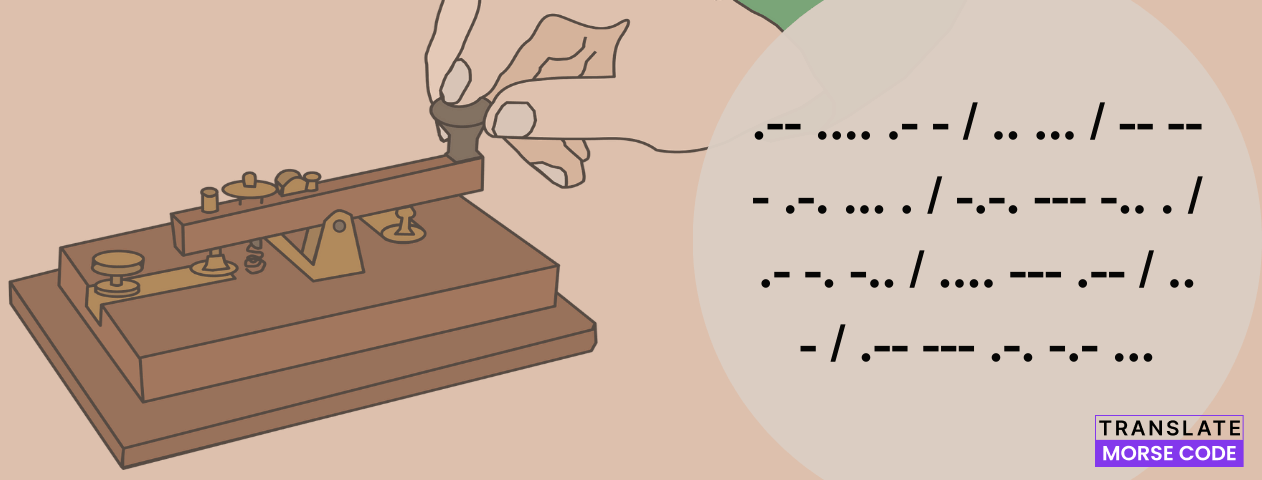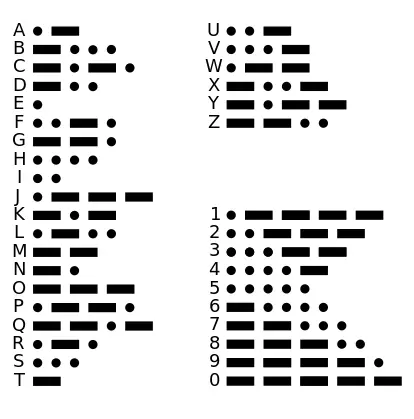What is Morse Code and How It Works

In today's world of instant communication through smartphones, emails, and social media, it is easy to forget that not too long ago, Morse code was a vital means of long-distance communication. Morse code still remains a fascinating and enduring method of conveying messages using a simple system of dots and dashes. This article will explore what is Morse code, its history, how it works, and its enduring relevance.
What is Morse Code?
Morse Code is a character encoding system that uses a combination of dots and dashes to represent letters, numbers, and symbols. It was developed in the early 1830s by Samuel Morse and Alfred Vail as a means of transmitting messages over long distances using telegraph systems. The code is based on a simple principle: each letter of the alphabet and each digit is assigned a unique combination of short signals (dots) and long signals (dashes). These dots and dashes are known as "Morse Code symbols."
The basic Morse Code symbols include:
- Dot (·): A short signal, also known as a "dit."
- Dash (-): A long signal, also known as a "dah."
The Origin and History of Morse Code:
Morse code was invented by Samuel Morse and Alfred Vail in the early 1830s as a means of transmitting messages via telegraph wires. Its simplicity and reliability made it the go-to method for long-distance communication during the 19th and 20th centuries. Telegraph operators would tap out messages using telegraph keys, creating a unique auditory language that became synonymous with the modern age.
Over the years, Morse code played a crucial role in various historical events, including ship-to-shore communication, aviation, and wartime efforts. Today, while it has largely been replaced by digital technologies, it remains an important backup system in case of emergencies.
Who was Samuel Morse?
Samuel Morse was an American inventor and artist, born on April 27, 1791. He is most renowned for developing the Morse Code and the electric telegraph, two pivotal innovations that revolutionized long-distance communication. His invention of the Morse Code, a system of dots and dashes representing letters and numbers, became the foundation for efficient telegraphy.
In collaboration with Alfred Vail, Morse demonstrated the practicality of his telegraph system in the early 1830s. The Morse code invention was a watershed moment in history, enabling messages to be transmitted rapidly across vast distances, profoundly impacting communication, commerce, and transportation.
Samuel Morse's contributions extended beyond technology; he was also a skilled portrait artist. His legacy endures not only in the realm of communication but in the art world as well. Morse's work significantly advanced the capabilities of global communication, connecting people and places in a way that was previously unimaginable. His name is forever linked with the Morse Code and the evolution of long-distance messaging.
The Story Behind This Invention by Samuel Morse
The story behind Samuel Morse's invention of the telegraph and Morse Code is a fascinating tale of innovation and perseverance. In the early 1830s, Morse was a portrait artist and a professor of arts at the University of the City of New York. During this period, he received a letter that would change the course of his life.
Morse received a letter informing him of his wife's grave illness. Unfortunately, by the time he reached his home, she had already been buried. This tragic incident, coupled with his observation of recent advancements in electromagnetism, ignited Morse's interest in improving long-distance communication.
Over the next several years, Morse dedicated himself to developing a practical telegraph system.
1st Morse Code Transmission
In collaboration with Alfred Vail, an enthusiastic young inventor, he refined his ideas. They created a system of dots and dashes, which became known as Morse Code, to represent letters and numbers. Morse and Vail also developed the telegraph key, which allowed operators to send messages by tapping out the code.
In 1838, Morse demonstrated the first successful telegraph line covering a distance of two miles in New Jersey. Despite facing skepticism and financial challenges, he continued to refine and promote his invention. By 1844, Morse's telegraph line extended from Washington, D.C., to Baltimore, Maryland, and the first telegraph message sent was "What hath God wrought!"
The telegraph and Morse Code revolutionized communication, allowing messages to be transmitted rapidly over vast distances. Samuel Morse's invention had a profound impact on society, commerce, and transportation, shaping the way we communicate even to this day. His dedication and innovation turned a personal tragedy into a transformative moment in history.
How Does Morse Code Work?

The key to understanding Morse Code is its reliance on a series of short and long signals to represent letters, numbers, and other characters. Each character is separated by spaces, while words are separated by slightly longer spaces. Here is a simplified example of Morse Code symbols for the alphabet:
To form a Morse Code message, you simply translate each character of the message into its corresponding Morse Code symbol and then string them together with appropriate spacing to form the complete message. For example, the word "HELLO" in Morse Code would be written as ".... . .-.. .-.. ---".
Also, check out how to say “Yes” and ”No” in Morse code.
Timing Rule
Each dot, dash, and pause corresponds to a defined unit of time, which can be measured in seconds, milliseconds, or even shorter intervals, depending on your chosen transmission speed.
Here are the fundamental timing rules for Morse Code for how to use Morse code:
- A dot is represented by a single unit of time.
- A dash is conveyed with three consecutive units of time.
- Pause between dots and dashes is one unit of time.
- When separating letters, a pause of three units of time is observed.
- To signify the conclusion of words, maintain a pause lasting seven units of time.
By adhering to these timing rules, you ensure that your Morse Code message flows coherently, allowing the recipient to accurately decode the transmitted information. This knowledge enables you to master the elegant language of dots and dashes, transcending conventional written communication.
What was Morse code used for?
Before the emergence of Morse code and the telegraph, handwritten messages had to rely on horseback for delivery. These revolutionary technologies transformed the way we convey information. At its inception, Morse code represented a breakthrough in long-distance communication, standing out as the swiftest method available.
Morse code introduced a novel means for ships at sea to establish communication across vast expanses through the use of substantial lights. This advancement proved especially pivotal during World War II, significantly accelerating the exchange of vital information. Naval vessels efficiently linked with their home bases and shared critical data among themselves. Furthermore, warplanes harnessed Morse code to pinpoint the whereabouts of enemy ships, bases, and troops, transmitting this intelligence back to headquarters. In an era marked by rapid advancements, Morse code emerged as a critical tool, transforming communication across land and sea.
Is Morse Code Still Used Today?
Morse Code, with its distinctive combination of dots and dashes, stands as a testament to human ingenuity in communication. While it may no longer dominate the world of long-distance messaging, it has managed to carve out its niche, retaining a relevance that transcends the pages of history. Here are the applications that what is Morse Code used for in our contemporary world:
Morse Code in Amateur Radio
One might assume that Morse Codes' relevance in today's digital age would be minimal, but a thriving community of amateur radio enthusiasts proves otherwise. These radio aficionados have adopted Morse Code as a preferred mode of communication for its resilience in challenging conditions. While it is no longer a requirement to obtain an amateur radio license, many operators still value the efficiency and reliability of Morse Code for long-distance conversations.
Aviation and Aeronautical Fields
The skies are not immune to the resonance of Morse Code. In aviation and aeronautical fields, this venerable code still finds purpose. Radio navigational aids, such as VORs (VHF Omni-Directional Range) and NDBs (Non-Directional Beacon), continue to identify themselves using Morse Code. It serves as a fundamental means of transmitting essential information to aircraft, ensuring safe navigation through the skies.
Maritime Morse Code
Over the open seas, the sound of Morse Code still echoes. The U.S. Navy and Coast Guard maintain the use of signal lamps to communicate via Morse Code, particularly in situations where electronic communication may not be viable or secure. This maritime tradition showcases Morse Codes' steadfast role in the realm of sea-based operations.
Morse Codes Multifaceted Utility
While Morse Code may not be as omnipresent as it once was, it continues to exhibit remarkable versatility. It offers a range of functions in diverse contexts that how is Morse code used today, including:
Emergency Signaling: The simplicity and clarity of Morse Code make it an invaluable tool for signaling distress. The internationally recognized SOS signal (... --- ...) epitomizes its role in saving lives during critical situations.
Education and Personal Challenge: For many, learning Morse Code represents a personal challenge or a rewarding hobby. The pursuit of mastery in this unique form of communication, with the help of a Morse Code Maker, can be an intellectually stimulating and satisfying endeavor.
Cryptography and Security: In certain instances, Morse Code has found a new role in the realm of cryptography. Its simplicity can be leveraged to encode messages, adding an extra layer of security to sensitive communications.
Morse Code Message Examples
Morse Code messages can convey a wide range of information, from simple greetings to critical distress signals. Here are some examples of Morse Code messages:
SOS:
Perhaps the most well-known Morse Code message, "SOS" (... --- ...) is used to indicate an urgent call for help or a distress signal.
I Love You:
To send a heartfelt greeting I Love You in Morse Code, you would transmit (.. / .-.. --- ...- . / -.-- --- ..-).
Morse Code Name:
You can spell your name in Morse Code by using the appropriate symbols. For example, "JOHN" would be ".--- --- .... -."
Numbers:
Numbers 0-9 have their own Morse Code representations, making it possible to send numerical data as well.
QTH (Location):
In amateur radio, "QTH" is used to request the sender's location. The Morse Code message for QTH is "--.- - ...." followed by the specific location in plain language.
Conclusion
Morse code, with its dots and dashes, stands as a testament to the ingenuity of human communication. This article presented complete information about what is Morse Code, its historical significance, versatility, and enduring relevance in various domains. While modern technology has rendered Morse code largely obsolete in everyday life, its legacy as a fascinating language of communication continues to captivate the curious, inspire the creative, and remind us of a time when the exchange of messages was an art and a science.